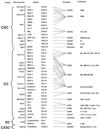Chemokines: key players in cancer progression and metastasis
- PMID: 21622291
- PMCID: PMC3760587
- DOI: 10.2741/246
Chemokines: key players in cancer progression and metastasis
Abstract
Instructed cell migration is a fundamental component of various biological systems and is critical to the pathogenesis of many diseases including cancer. Role of chemokines in providing navigational cues to migrating cancer cells bearing specific receptors is well established. However, functional mechanisms of chemokine are not well implicit, which is crucial for designing new therapeutics to control tumor growth and metastasis. Multiple functions and mode of actions have been advocated for chemokines and their receptors in the progression of primary and secondary tumors. In this review, we have discussed current advances in understanding the role of the chemokines and their corresponding receptor in tumor progression and metastasis.
Figures


Similar articles
-
Chemokine biology in cancer.Semin Immunol. 2003 Feb;15(1):49-55. doi: 10.1016/s1044-5323(02)00127-6. Semin Immunol. 2003. PMID: 12495640 Review.
-
Beyond Cell Motility: The Expanding Roles of Chemokines and Their Receptors in Malignancy.Front Immunol. 2020 Jun 4;11:952. doi: 10.3389/fimmu.2020.00952. eCollection 2020. Front Immunol. 2020. PMID: 32582148 Free PMC article. Review.
-
Chemokines in tumor immunotherapy.Front Biosci. 2006 Jan 1;11:1024-30. doi: 10.2741/1860. Front Biosci. 2006. PMID: 16146794 Review.
-
Chemokines and cancer: migration, intracellular signalling and intercellular communication in the microenvironment.Biochem J. 2008 Feb 1;409(3):635-49. doi: 10.1042/BJ20071493. Biochem J. 2008. PMID: 18177271 Review.
-
Chemokines and chemokine receptors--Keystone Symposium highlights 7-12 January 2003, Breckenridge, CO, USA.IDrugs. 2003 Mar;6(3):195-6. IDrugs. 2003. PMID: 12841177 No abstract available.
Cited by
-
CXCL2-CXCR2 axis mediates αV integrin-dependent peritoneal metastasis of colon cancer cells.Clin Exp Metastasis. 2021 Aug;38(4):401-410. doi: 10.1007/s10585-021-10103-0. Epub 2021 Jun 11. Clin Exp Metastasis. 2021. PMID: 34115261 Free PMC article.
-
Expression of CXC chemokine receptor-4 and forkhead box 3 in neuroblastoma cells and response to chemotherapy.Oncol Lett. 2014 Jun;7(6):2083-2088. doi: 10.3892/ol.2014.2028. Epub 2014 Apr 3. Oncol Lett. 2014. PMID: 24932293 Free PMC article.
-
Virotherapy-recruited PMN-MDSC infiltration of mesothelioma blocks antitumor CTL by IL-10-mediated dendritic cell suppression.Oncoimmunology. 2018 Oct 16;8(1):e1518672. doi: 10.1080/2162402X.2018.1518672. eCollection 2019. Oncoimmunology. 2018. PMID: 30546960 Free PMC article.
-
Chimeric Antigen Receptor (CAR) T Cell Therapy for Metastatic Melanoma: Challenges and Road Ahead.Cells. 2021 Jun 9;10(6):1450. doi: 10.3390/cells10061450. Cells. 2021. PMID: 34207884 Free PMC article. Review.
-
Multi-marker analysis of genomic annotation on gastric cancer GWAS data from Chinese populations.Gastric Cancer. 2019 Jan;22(1):60-68. doi: 10.1007/s10120-018-0841-y. Epub 2018 Jun 1. Gastric Cancer. 2019. PMID: 29859005
References
-
- Sporn MB. The war on cancer. Lancet. 1996;347(9012):1377–1381. - PubMed
-
- Nicolson GL. Cancer progression and growth: relationship of paracrine and autocrine growth mechanisms to organ preference of metastasis. Exp Cell Res. 1993;204(2):171–180. - PubMed
-
- Zlotnik A. Involvement of chemokine receptors in organ-specific metastasis. Contrib Microbiol. 2006;13:191–199. - PubMed
-
- Uchida D, Begum NM, Tomizuka Y, Bando T, Almofti A, Yoshida H, Sato M. Acquisition of lymph node, but not distant metastatic potentials, by the overexpression of CXCR4 in human oral squamous cell carcinoma. Lab Invest. 2004;84(12):1538–1546. - PubMed
-
- Payne AS, Cornelius LA. The role of chemokines in melanoma tumor growth and metastasis. J Invest Dermatol. 2002;118(6):915–922. - PubMed
Publication types
MeSH terms
Substances
Grants and funding
LinkOut - more resources
Full Text Sources

